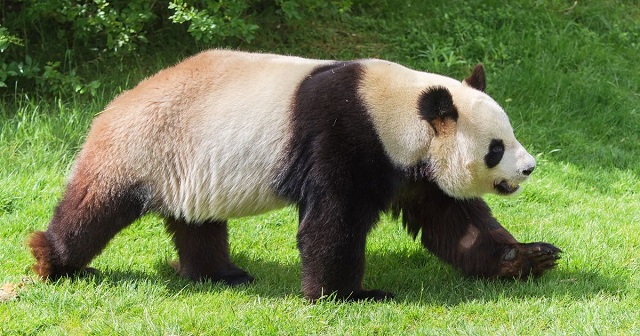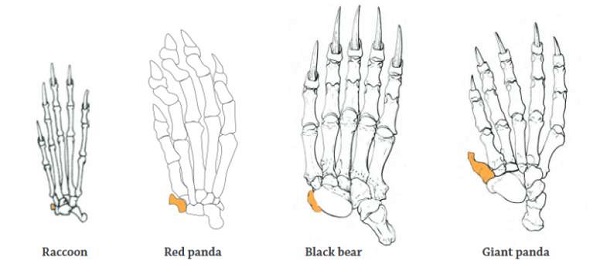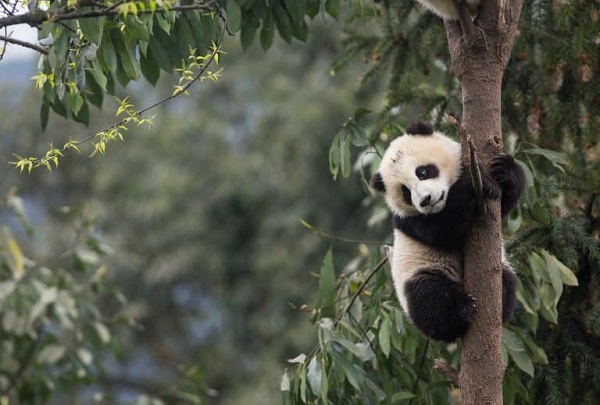
The Giant Panda (Ailuropoda melanoleuca) is also known by several other names, including simply Panda, Great Panda, and Panda Bear. It is a bear famous for its love of bamboo. It is native to selected mountain ranges in southwestern China.
Its habitat is in the mountain ranges and forests. They are mainly located in Southern Central China. The life span of a giant panda is usually 14-30 years, with their size 4 – 6.2 ft (1.2 to 1.9 m), and they weigh 160 – 300 pounds (70 – 135 kg).
Their colours are usually black and white. They feed on bamboo, which is 99% of their diet; occasionally, they feed on grass, rodents, and birds. Predators like Snow Leopards and Jackals can kill a panda cub.
The top speed of a giant panda is 32 kph (20 mph). They have only one species, and their conservation status is vulnerable.
Giant pandas typically inhabit regions that are high in elevation, between 4,000 and 11,500 feet, which they share with other rare animals such as the Sichuan takin. Pandas prefer living in damp, misty forested areas.
Giant pandas have specific needs and they include having at least two species of bamboo and a water source contained within an old-growth conifer forest. This type of forest offers large tree stumps and hollow logs that are the right size for panda dens. The other benefits to this type of habitat are that shelter and nutrients are present for the bamboo that grows there.
The giant panda was once widespread throughout China, and even Myanmar and northern Vietnam. However, they have been on the endangered species list from 1990 to 2016, before this was switched to vulnerable – mainly due to habitat loss, poaching and poor breeding.
The giant panda can now only be found in 20 isolated patches of bamboo forest in six mountain ranges in China’s Sichuan, Shaanxi and Gansu provinces, with most in the Minshan and Qinling mountains.
See some Interesting Facts About the Giant Panda
1. Giant Pandas Consume 20kg of Bamboo Each Day

They will spend at least 12 hours of the day dining on it. Bamboo is so nutritionally poor, pandas must consume a high volume to get any benefit out of it.
2. They Do Not Weigh Much After Eating So Much Bamboo
The male panda is the heavier of the genders, weighing in at somewhere between 75 and 135 kilograms. Females, on the other hand, weigh between 70 and 100 kilograms.
3. Giant Pandas Have Evolved A Unique Opposable Thumb, Which They Use To Hold Bamboo Stalks

This ‘thumb’ is an enlarged and modified wrist bone, which is also present (in ‘original form) in raccoon, red panda, and black bear. It helps pandas handle bamboo, as they peel and eat it. A giant panda can peel and eat a bamboo shoot in around 40 seconds.
4. Giant Pandas Have Teeth Of A Carnivore, But Are Herbivores
Pandas are thought to have evolved from eating animals and plants, to an almost exclusive bamboo diet about 2 million years ago.
5. Giant Panda Guts Are Not Suited To Bamboo
While they may have evolved to eat bamboo, researchers found their gut has not adapted so well. Their digestive systems are still better suited to a carnivorous diet. Scientists believe this increases their risk of extinction.
6. Males Have A Larger Range Than Females
Panda home ranges cover roughly five square kilometres. The male range is on the upper end of that, with females holding a slightly smaller territory.
7. All Giant Pandas In The World Are Chinese Citizens
As the giant panda is a Chinese national treasure and protected by law, if you see one in a reserve or zoo somewhere else in the world, that panda is actually on loan from China. The arrangement is a little more complicated than that, as each time a cub is born, it has to be sent back to China in order to assist in expanding the giant panda gene pool.
8. China Rents Giant Pandas to American Zoos for $1m per Year
Zoos typically sign a 10-year contract to ‘rent’ a giant panda. If a cub is born, they costs $400k and is shipped back at 3 years old to help breed.
9. Despite Their Low Population, They Keep Increasing
In the 1970’s there were only about 1,000 pandas on the planet. A census taken in 2014 showed that the figure had increased to 1,864 pandas living in the wild.
10. Giant Pandas Can Swim And Climb Trees

Giant pandas can climb from around 6 months old, and like all bears, can swim rather well when required.
12. Pandas Can Live Almost Twice As Long In Captivity As In The wild
The average life span of a panda is between 14 and 20 years. That figure jumps to 30 years for those living in captivity.
13. Giant Pandas Are Lazy
Pandas spend most of their time either eating or sleeping. Breeding is seemingly not high on their list of priorities.
YOU MAY ALSO LIKE: 10 Laziest Animals in the World
14. Their Reproductive Cycle Is A Tad On The Slow Side
Mature females will breed once every two or three years in the wild. She will have around 5 litters in her lifetime.
15. Giant Pandas Start Life With Pink Skin
When first born, a panda cub has pink skin, is about 15cm in size, and is covered with a very thin coat of white fur. It also has a long tail, no teeth and its eyes are closed.
RELATED: 15 Strange Facts About the Animal Kingdom
In a month, that cub will have most of its black spots, and its eyes will open in the following couple of weeks. By the time the cub reaches 14 weeks of age, its teeth will start to appear. At this point, both the cub and its mother will use their den less frequently.
16. Pandas Make A Lot Of Different Noises.
These bears do not roar, but they are fairly vocal otherwise. In addition to sounds that resemble those of a baby goat or lamb, a panda can growl, bark, huff and honk.
17. The Panda Has A Relatively Large Repertoire.
Researchers have been able to clearly identify a total of 11 different panda calls. They even say that four of them are reserved for when the panda is seeking a mate.
18. The Panda Is A Symbol Of Peace And Friendship In China
Hundreds of years ago in times of war, tribes would raise a flag with a panda on it to stop a battle and call a truce.



